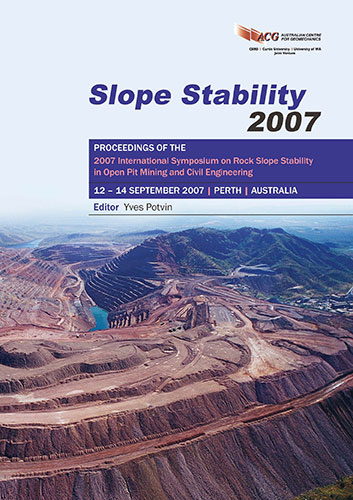Fact and Fiction About Pit Slope Depressurization

|
Authors: Harman, J; Hormazabal, E; Martinez, C Paper is not available for download Contact Us |
DOI https://doi.org/10.36487/ACG_repo/708_22
Cite As:
Harman, J, Hormazabal, E & Martinez, C 2007, 'Fact and Fiction About Pit Slope Depressurization', in Y Potvin (ed.), Slope Stability 2007: Proceedings of the 2007 International Symposium on Rock Slope Stability in Open Pit Mining and Civil Engineering, Australian Centre for Geomechanics, Perth, pp. 362-370, https://doi.org/10.36487/ACG_repo/708_22
Abstract:
The adverse effects of groundwater pressures on slope stability have been recognised for many years, and measures to mitigate such effects in civil engineering projects have been developed to a high degree of sophistication. Engineers routinely provide for groundwater in their analyses, especially when working with soils or weak rock, in projects such as road cuttings, soil slopes, etc. In recent years the effects of water pressures on pit slope stability have increasingly concerned open pit designers and geotechnical engineers. The concerns have grown as deeper open pits are considered and optimization (steepening) of the wall angle becomes a critical aspect. A number of pit wall failures have been attributed, at least in part, to the aggravating effects of water. In the past, engineers have factored (the effects of) water into their analyses as one of the many variables together with geology, rock quality characteristics, etc. The use of numerical modelling is now being used increasingly to predict pore pressures. This paper argues that the recent availability and ease of use of sophisticated numerical techniques, both for modelling groundwater flow and for geotechnical analysis, may have led to the overdependence on a ‘black box’ solution with a lesser reliance being placed on solid engineering and geological judgment. Critical field investigations are often not carried out or are downgraded in importance. The paper discusses the concerns of the authors that arise from the wide variation in the approaches taken to address what is seen as a very important topic in current geotechnical design and the lack of importance that is generally given to adequate data gathering which is critical if advances are to be made.
References:
Cedergren, H.R. (1967) Seepage, drainage and flow nets, 1st edition, John Wiley & Sons, New York.
Dupuit, J. (1863) Etudes theoriques et practiques sur le movement des eaux dans les canaux decouverts et a travers les
terrains permeables, Paris.
González de Vallejo, L.I., Ferrer, M., Ortuño, L. and Oteo, C. (2002) Ingeniera Geologica, 1st edition, Pearson
Educación, Madrid.
Harr, M.E. (1962) Groundwater and seepage, 2nd edition, Dover Publications, New York.
Hormazabal, E. (2005) Estimating flow and pore pressures in open pit mines. MSc thesis, Department of Geology &
Geophysics, Boston College.
Kozeny, J. (1931) Grundwasserbewegung bei freiem Spiegel, Fluss und Kanalversickerung, Wasserkraft und
Wasserwirtschaft, No 3.
Wasy GmbH (2005) FeFlow 5.2: Finite Element Subsurface Flow & Transport Simulation System, Institute for Water
Resources Planning and Systems Research, Germany.
Fact and Fiction About Pit Slope Depressurisation J. Harman, et al.
370 Slope Stability 2007, Perth, Australia
© Copyright 2025, Australian Centre for Geomechanics (ACG), The University of Western Australia. All rights reserved.
View copyright/legal information
Please direct any queries or error reports to repository-acg@uwa.edu.au
View copyright/legal information
Please direct any queries or error reports to repository-acg@uwa.edu.au